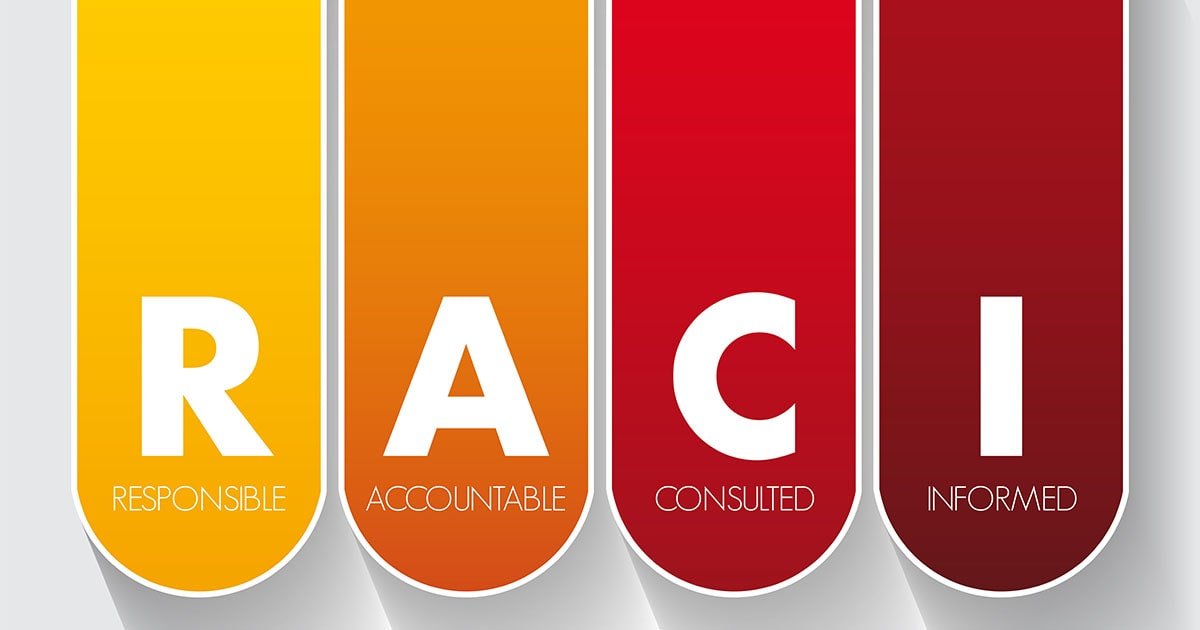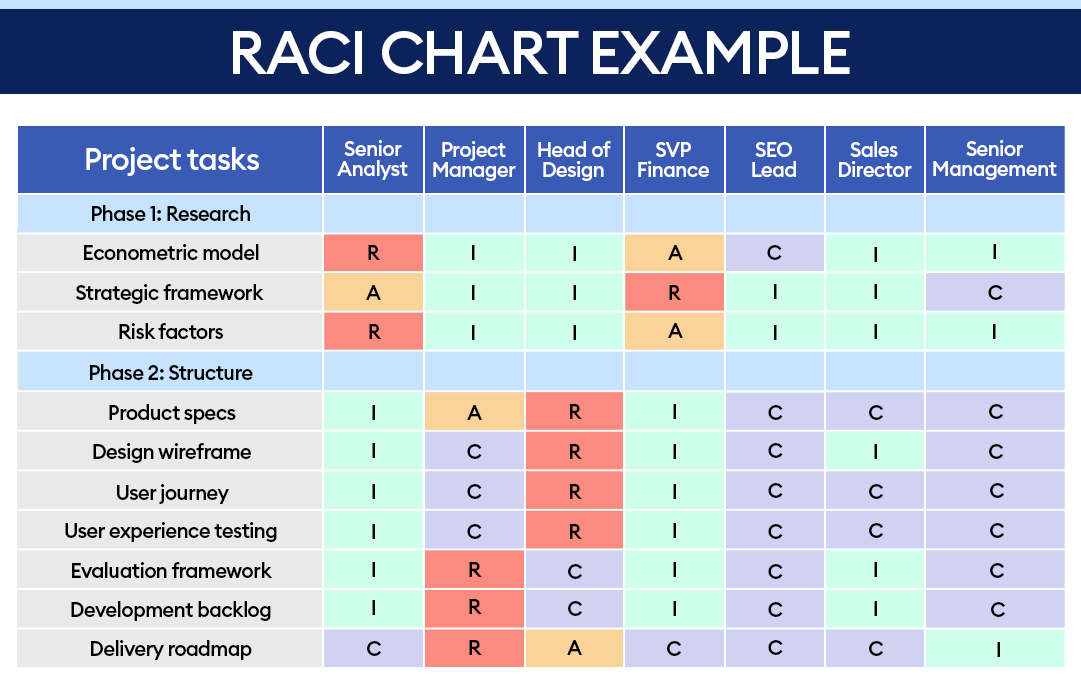
Introduction:
It is a tool used in project management to clarify roles and responsibilities within a team. RACI stands for Responsible, Accountable, Consulted, and Informed. Each letter represents a different role that a team member may have in relation to a specific task or deliverable.
- Responsible: The person or group responsible for executing the task or decision.
- Accountable: The person or group ultimately answerable for the completion of the task or decision.
- Consulted: The person or group whose opinions are sought before a final decision or action is taken.
- Informed: The person or group kept up-to-date on progress, often after decisions are made.
This template helps in ensuring that everyone understands their specific role, reducing ambiguity and increasing efficiency.
Related Article: Product Cost Analysis Template
Implementing the RACI Matrix Template:
Implementing this template involves several steps. Each step ensures that the template serves its intended purpose and aligns with the project’s needs.
- Identify the Tasks: The first step is to list all the tasks or deliverables that need completion within the project. These tasks form the rows of the RACI Matrix.
- Identify the Roles: Next, identify all the roles or team members involved in the project. These roles form the columns of the RACI Matrix.
- Assign RACI to Each Task: For each task, assign the appropriate role to each team member. This involves deciding who will be responsible, accountable, consulted, and informed for each task.
- Review and Adjust: Once the initial RACI Matrix is complete, review it with the team. Make adjustments if necessary to ensure that the roles are clear and that there is no overlap or confusion.
- Communicate the Matrix: Finally, communicate the RACI Matrix to the entire team. Ensure that everyone understands their role and how they fit into the project.
By following these steps, the template becomes a powerful tool for project management, helping to streamline processes and improve collaboration.
Related Article: Project Risk Register Template
Defining the Key Benefits:
This template offers several benefits in project management, making it an essential tool for teams of all sizes and industries.
- Clarity in Roles and Responsibilities: This template clearly defines who is responsible, accountable, consulted, and informed for each task. This reduces confusion and ensures that everyone knows what is expected of them.
- Improved Communication: By defining roles, this template enhances communication within the team. Team members consult the right people for specific tasks and keep others informed, leading to more efficient communication.
- Enhanced Accountability: This template ensures that someone is accountable for each task. This accountability drives performance and ensures that tasks are completed on time.
- Balanced Workload: By clearly assigning roles, the template helps in distributing the workload evenly across the team. This prevents overloading any one team member and ensures that everyone contributes to the project’s success.
- Effective Decision-Making: The RACI matrix templates identify who should be consulted before making decisions and who has the final say. This streamlines the decision-making process and ensures that decisions are made quickly and effectively.
- Flexibility: This template can be adapted to suit different projects and teams. Whether working on a small project with a few team members or a large, complex project, the template can be customized to fit the specific needs.
Related Article: Agile Project Management Template
Identifying the Challenges:
While this template offers many benefits, it is not without challenges. Understanding these challenges can help in overcoming them and making the most of the template.
- Over-Complication: One of the common challenges with this template is over-complicating the roles. Sometimes, assigning multiple roles to team members for the same task leads to confusion. Keeping the matrix simple and straightforward is key to avoiding this pitfall.
- Resistance to Change: Introducing the template in a team that has not used it before may face resistance. Some team members may struggle to adapt to the new structure. In such cases, providing proper training and emphasizing the benefits of the template can help ease the transition.
- Inflexibility in Dynamic Environments: In fast-paced or dynamic project environments, this template may become outdated quickly. Tasks and roles may change frequently, requiring constant updates to the matrix. To mitigate this, regular reviews and updates to the RACI Matrix are essential.
- Misinterpretation of Roles: Misunderstanding the roles in this template can lead to issues. For example, if a team member misunderstands the difference between being responsible and accountable, it can lead to tasks falling through the cracks. Clear communication and training on the template’s use can prevent this.
- Lack of Buy-In: For the template to be effective, all team members must buy into it. If some team members do not take the matrix seriously, it can undermine the entire project. Ensuring that everyone understands the importance of the template and their role within it is crucial for success.
Related Article: Kanban Project Management Tools

Adapting the RACI Matrix Template for Different Projects:
The versatility of this template makes it suitable for various types of projects. However, slight adaptations may be necessary depending on the project’s nature.
Small Teams: In small teams, one person may take on multiple roles. This template can still be effective, but it may need to reflect the fact that one individual is both responsible and accountable for a task. Clear communication becomes even more critical in these cases.
Large Projects: For large, complex projects with many tasks and team members, the template can become quite detailed. Breaking down the matrix into smaller sections or phases of the project can make it more manageable.
Agile Environments: In agile project management, where roles and tasks may change frequently, this template needs to be flexible. Incorporate regular updates and reviews of the matrix into the project schedule to ensure it remains relevant.
Cross-Functional Teams: When working with cross-functional teams, the RACI Matrix Template can help clarify roles across different departments. It ensures that everyone understands their responsibilities, even when working with team members from different areas of the organization.
Also Checkout our Advanced Business Roadmap Templates
Best Practices:
- Keep It Simple: The matrix should be as simple and clear as possible. Avoid over-complicating the template with too many roles or tasks.
- Involve the Team in Creation: Involve the entire team in creating the template. This involvement ensures that everyone understands their roles and responsibilities.
- Review Regularly: Regularly review the matrix to ensure it remains relevant to the project. Update the template as necessary to reflect any changes in the project.
- Ensure Clear Communication: Communicate the matrix clearly to all team members. Make sure everyone understands their roles and the expectations associated with them.
- Assign One Accountable Person Per Task: Each task should have only one accountable person. This rule ensures clarity and prevents confusion over who is ultimately responsible for the task.
Read More: responsibility assignment matrix
Conclusion:
In short, the RACI Matrix Template remains a powerful tool for project management in 2024.


